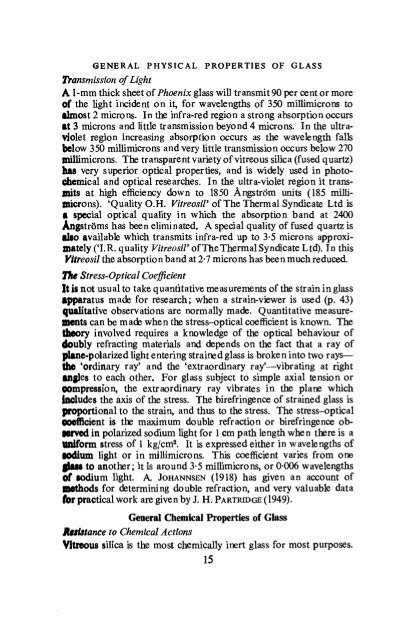Laboratory Glass-Working for Scientists - Sciencemadness Dot Org
Laboratory Glass-Working for Scientists - Sciencemadness Dot Org
Laboratory Glass-Working for Scientists - Sciencemadness Dot Org
You also want an ePaper? Increase the reach of your titles
YUMPU automatically turns print PDFs into web optimized ePapers that Google loves.
©ENERAL PHYSICAL PROPERTIES OF GLASS<br />
Transmission of Light<br />
A 1-mm thick sheet of Phoenix glass will transmit 90 per cent or more<br />
Of the light incident on it, <strong>for</strong> wavelengths of 350 millimicrons to<br />
Almost 2 microns. In the infra-red region a strong absorption occurs<br />
at 3 microns and little transmission beyond 4 microns. In the ultraviolet<br />
region increasing absorption occurs as the wavelength falls<br />
below 350 millimicrons and very little transmission occurs below 270<br />
millimicrons. The transparent variety of vitreous silica (fused quartz)<br />
has very superior optical properties, and is widely used in photochemical<br />
and optical researches. In the ultra-violet region it transmits<br />
at high efficiency down to 1850 Angstrom units (185 millimicrons).<br />
'Quality O.H. VitreosiV of The Thermal Syndicate Ltd is<br />
A special optical quality in which the absorption band at 2400<br />
Angstrdrns has been eliminated. A special quality of fused quartz is<br />
also available which transmits infra-red up to 3*5 microns approximately<br />
('I.R. quality VitreosiV of The Thermal Syndicate Ltd). In this<br />
Vitreosil the absorption band at 2*7 microns has been much reduced.<br />
The Stress-Optical Coefficient<br />
It IS not usual to take quantitative measurements of the strain in glass<br />
apparatus made <strong>for</strong> research; when a strain-viewer is used (p. 43)<br />
qualitative observations are normally made. Quantitative measure-<br />
Kits can be made when the stress-optical coefficient is known. The<br />
M -- i<br />
j^'t<br />
involved requires a knowledge of the optical behaviour of<br />
doubly refracting materials and depends on the fact that a ray of<br />
p!ane»polarized light entering strained glass is broken into two rays—<br />
the 'ordinary ray' and the 'extraordinary ray'—vibrating at right<br />
•llgles to each other. For glass subject to simple axial tension or<br />
Compression, the extraordinary ray vibrates in the plane which<br />
includes the axis of the stress. The birefringence of strained glass is<br />
proportional to the strain, and thus to the stress. The stress-optical<br />
OOefficient is the maximum double refraction or birefringence obgerved<br />
in polarized sodium light <strong>for</strong> 1 cm path length when there is a<br />
Uni<strong>for</strong>m stress of 1 kg/cm 2 . It is expressed either in wavelengths of<br />
•Odium light or in millimicrons. This coefficient varies from one<br />
glass to another; it is around 3*5 millimicrons, or 0*006 wavelengths<br />
of sodium light A. JOHANNSEN (1918) has given an account of<br />
methods <strong>for</strong> determining double refraction, and very valuable data<br />
<strong>for</strong> practical work are given by J. H. PARTRIDGE (1949).<br />
Resistance to Chemical Actions<br />
General Chemical Properties of <strong>Glass</strong><br />
Vittoous silica is the most chemically inert glass <strong>for</strong> most purposes.<br />
15
















